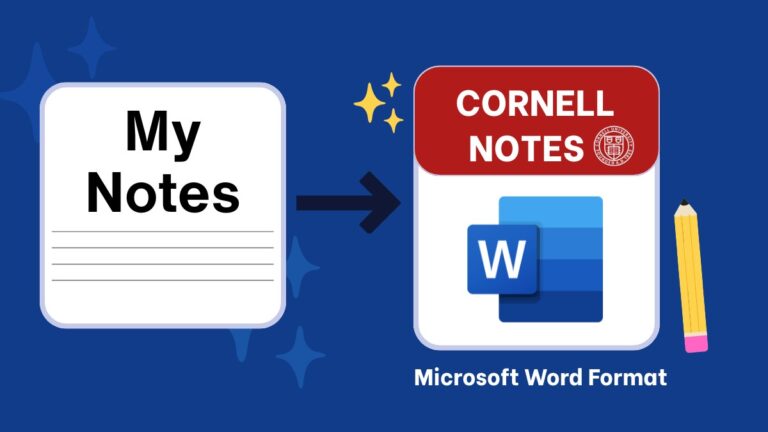Using AI for note-taking can turn a messy week of lectures into clean notes, targeted study guides, and quiz questions you can actually review. Here’s the exact workflow I use each week to stay on top of my classes. Try the free Study Pack Generator.
What you’ll learn
- How I capture lectures with AI
- How I turn raw notes into organized outlines
- How I generate study guides, flashcards, and quizzes
- How I keep everything accurate and aligned with my syllabus
You can follow this process with Polar Notes AI free Study Pack Generator or a similar AI note-taking tool that supports transcripts and study-guide generation.
Step 1: Capture every lecture once, not five times
1.1 Prepare before class
Before the week starts, I:
- Check my syllabus and add all lecture times to my calendar.
- Open my AI note-taking app and create a notebook for each course.
- Add the week’s topics (e.g., “Bio 101 – Week 4: Cell Membranes & Transport”) so AI can label content correctly.
If your app supports it, turn on automatic lecture capture or keep a “New Lecture Notes” template ready.
1.2 Record or import the lecture
During each lecture, I do light manual notes and let AI do the heavy lifting:
- If the class is in person and recording is allowed:
- I record audio and let the app transcribe it.
- I use Polar Notes AI free AI Study Pack Generator to convert my audio effectively
- If the class is online:
- I save or download the recording and upload it to the app later.
- If slides or PDFs are shared:
- I upload them so the tool can combine transcript + slide content.
Result: by the end of the week, I have a set of AI-generated notes for each lecture, even if my handwritten notes are minimal.
Quick check: Always follow your school’s recording and privacy rules. If in doubt, ask your instructor or check your syllabus.
Step 2: Turn raw AI notes into clean, structured lecture notes
Raw transcripts are not yet study-ready. I use AI to shape them into lecture notes I can actually read.
2.1 Generate structured notes with headings
Prompt: Turn transcript into lecture notes
-
Turn this transcript into clean lecture notes for a college-level student.
• Use clear headings and subheadings
• Pull out key terms and definitions
• Keep explanations short and focused
• Remove small talk and repeated content
The app then creates a structured document with:
- Topic title
- Main sections and subtopics
- Bullet points for the most important ideas
- Key terms bolded or in a dedicated list
2.2 Highlight key terms and examples
Next, I refine those notes:
- I ask AI to highlight key terms and give a one-sentence definition.
- I ask for one or two concrete examples per major concept, especially in math, science, and history courses.
Prompt: Key terms with examples
- From these notes, list the 10 most important key terms and give a one-sentence definition and one real-world example for each.
Step 3: Combine a full week of lectures into one master set of notes
Once the week ends, I want one unified set of notes instead of five separate files.
3.1 Merge notes from all lectures
- Select all lecture notes for the week from the same course.
- Ask AI to merge them by topic into one document.
- Remove anything off-topic or repeated.
- Create an AI generated Study Pack
Prompt: Merge weekly notes
- Combine these lecture notes into one organized set titled “Week 4 – Cell Membranes & Transport.” Group similar concepts together, remove repetition, and keep the structure logical for studying.
3.2 Align notes with the syllabus
To make sure I’m studying what will actually be tested:
- I paste in the topic list or learning objectives from the syllabus.
- I ask AI using the prompt below.
Prompt: Check coverage against objectives
- Check if these notes cover all of the following objectives. Point out any gaps and add missing explanations if needed.
Step 4: Turn AI notes into a study guide
With one master document for the week, I let AI reshape it into a focused study guide.
4.1 Pull learning objectives
Prompt: Generate learning objectives
- From these notes, write 8–12 learning objectives that describe what a student should be able to explain, calculate, or describe after Week 4.
This gives me a checklist like:
- Explain the structure and function of phospholipid bilayers
- Compare passive and active transport
- Describe how osmosis works across cell membranes
I keep this at the top of my study guide.
4.2 Generate a concise summary
Prompt: Write the weekly study guide
- Write a 1–2 page study guide that explains the main ideas from these notes in simple language for a college freshman. Use headings, short paragraphs, and bullet points.
- Underline anything confusing.
- Ask AI to re-explain confusing parts with simpler analogies.
- Add my own sentences in the margins.
The result is a human+AI study guide that actually makes sense to me.
Step 5: Create practice questions and quizzes
Now I use my AI notes to test myself.
5.1 Generate practice questions
Prompt: Build quiz questions
-
From these notes, generate:
• 10 multiple-choice questions
• 10 short-answer questions
• 5 exam-style free-response questions
Include answer keys.
I then:
- Export these into a quiz format or flashcards.
- Hide the answers and test myself before looking.
- Mark any questions I miss and tag the related concepts in my notes.
5.2 Build flashcards from key terms
Prompt: Create flashcards
-
Turn the key terms in these notes into front/back flashcards.
Front: term only.
Back: clear definition + short example.
I import them into my favorite flashcard app or keep them inside the AI tool, depending on what it supports.
Step 6: Review schedule for the week
Having AI notes, study guides, and quizzes is only useful if I review them in time.
My basic review plan:
- Same day as lecture:
- Skim AI notes
- Clarify any misunderstandings while the class is fresh
- End of the week:
- Read the weekly study guide
- Do at least one short quiz session (10–15 minutes)
- Before the exam:
- Re-do all quizzes
- Re-read learning objectives and confirm I can explain each one out loud
Because everything is already organized by AI, I can spend my time actually learning, not formatting notes.
Tips to keep AI note-taking accurate and ethical
Using AI doesn’t mean turning off your brain. I follow these rules so my notes stay useful and academic-safe:
- Always verify key facts. If something looks off, I check the textbook or lecture slides.
- Use AI as a study aid, not a shortcut. I don’t paste AI answers directly into homework or essays unless my instructor explicitly allows it.
- Respect privacy and school rules. I only record lectures where it’s permitted and I don’t share transcripts outside the class.
- Add my own thinking. I highlight tough concepts, jot down questions to ask in office hours, and adjust the study guide in my own words.
- Use reliable audio to note converts such as Polar Notes AI free AI Study Pack Generator
Sample prompts you can reuse
You can adapt these prompts inside your AI note-taking app:
Reusable prompts (copy friendly)
-
Turn lecture into notes
“Turn this transcript into clear lecture notes with headings, bullet points, and key terms. Remove small talk and repetition.” -
Create weekly master notes
“Combine these notes into ‘Week X – [Topic]’ notes. Group related ideas, remove duplicates, and organize logically for studying.” -
Build a study guide
“From these notes, write a 1–2 page study guide with learning objectives, short explanations, and bullet-point summaries.” -
Make quiz questions
“Generate 10 multiple-choice and 10 short-answer questions from these notes, with answer keys. Focus on the most test-worthy concepts.” -
Create flashcards
“List all key terms from these notes and turn them into flashcards with term on the front and definition + example on the back.”
Final thoughts: Let AI handle the busywork, you focus on learning
The real power of this workflow is simple:
- I capture each lecture once
- AI cleans and organizes it
- I turn that into study guides, quizzes, and flashcards
- I spend almost all my time reviewing and practicing, not rewriting notes
If you’re tired of scrambling before exams, try this process for one class and one week. Once you see how quickly you can turn a week of lectures into AI notes, study guides, and quizzes, it becomes your default way to study. Generate a study pack now or read the AI Note-Taking Guide. Visit the homepage for more tools.



